Real Life Baby Died of Malnutrition After Parents â€ëœrefused to Get Help for Religious Reasonsã¢â‚¬â„¢
What happens to our bodies after we die
(Image credit:
Getty Images
)
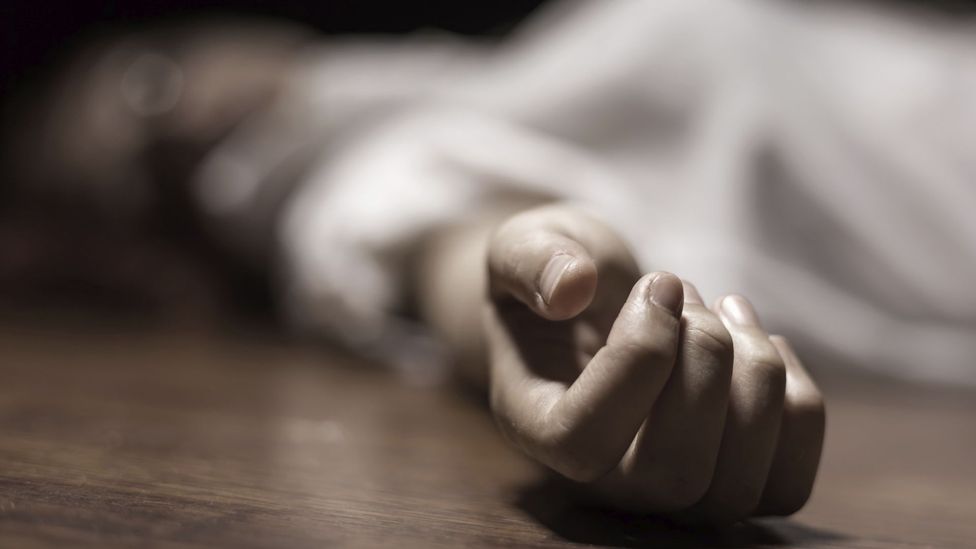
The breakdown of our bodies afterwards expiry tin be fascinating – if you dare to delve into the details. Mo Costandi investigates.
"It might take a little scrap of force to intermission this upwards," says mortician Holly Williams, lifting John'due south arm and gently angle it at the fingers, elbow and wrist. "Usually, the fresher a body is, the easier information technology is for me to work on."
Williams speaks softly and has a happy-become-lucky demeanour that belies the nature of her work. Raised and now employed at a family-run funeral domicile in north Texas, she has seen and handled dead bodies on an near daily basis since babyhood. Now 28 years sometime, she estimates that she has worked on something like 1,000 bodies.
Her work involves collecting recently deceased bodies from the Dallas–Fort Worth surface area and preparing them for their funeral.
"Most of the people nosotros pick upward die in nursing homes," says Williams, "but sometimes we become people who died of gunshot wounds or in a abandoned vehicle. Nosotros might get a call to pick up someone who died solitary and wasn't found for days or weeks, and they'll already exist decomposing, which makes my piece of work much harder."
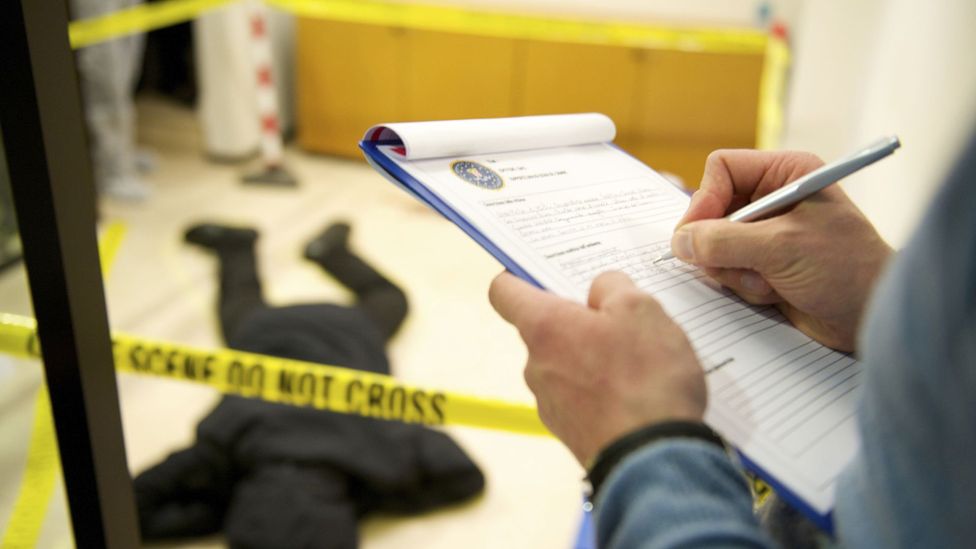
John had been expressionless almost four hours before his body was brought into the funeral home. He had been relatively healthy for most of his life. He had worked his whole life on the Texas oil fields, a job that kept him physically active and in pretty expert shape. He had stopped smoking decades before and drank alcohol moderately. Then, one cold Jan morning, he suffered a massive eye attack at home (apparently triggered by other, unknown, complications), cruel to the flooring, and died well-nigh immediately. He was just 57.
Now, John lay on Williams' metal table, his body wrapped in a white linen sheet, cold and stiff to the touch, his pare purplish-greyness – tell-tale signs that the early on stages of decomposition were well nether style.
Cocky-digestion
Far from being 'dead', a rotting corpse is teeming with life. A growing number of scientists view a rotting corpse as the cornerstone of a vast and complex ecosystem, which emerges presently after death and flourishes and evolves as decomposition proceeds.
Decomposition begins several minutes after death with a process called autolysis, or self-digestion. Soon afterward the heart stops beating, cells go deprived of oxygen, and their acidity increases every bit the toxic past-products of chemical reactions begin to accumulate inside them. Enzymes start to digest jail cell membranes and then leak out equally the cells break down. This usually begins in the liver, which is rich in enzymes, and in the brain, which has high water content. Eventually, though, all other tissues and organs begin to intermission down in this way. Damaged blood cells begin to spill out of broken vessels and, aided by gravity, settle in the capillaries and small veins, discolouring the skin.
Body temperature likewise begins to drib, until it has acclimatised to its environs. And so, rigor mortis – "the stiffness of decease" – sets in, starting in the eyelids, jaw and neck muscles, before working its way into the trunk and and so the limbs. In life, musculus cells contract and relax due to the deportment of two filamentous proteins (actin and myosin), which slide forth each other. After decease, the cells are depleted of their free energy source and the protein filaments go locked in place. This causes the muscles to become rigid and locks the joints.
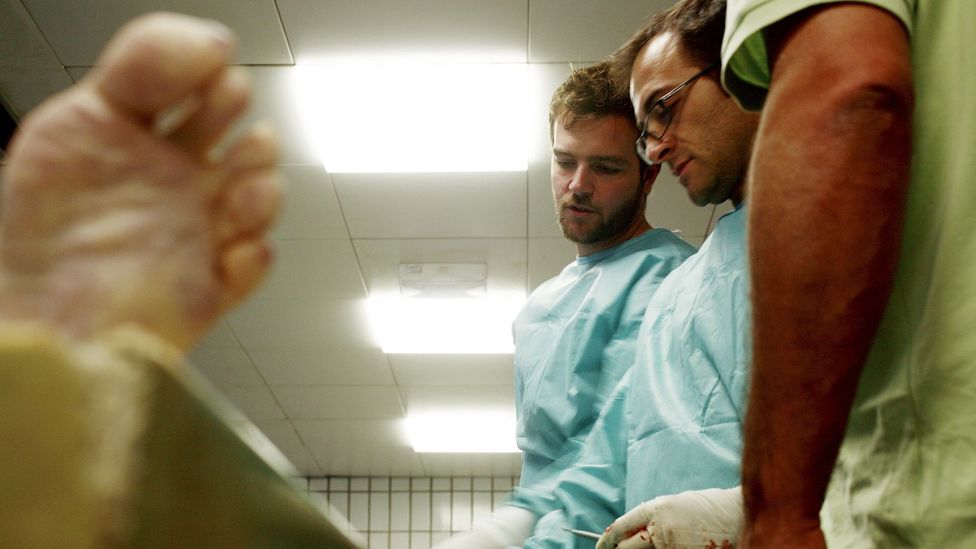
(Credit: Science Photo Library)
During these early on stages, the cadaveric ecosystem consists mostly of the bacteria that live in and on the living human body. Our bodies host huge numbers of bacteria; every 1 of the body'southward surfaces and corners provides a habitat for a specialised microbial community. By far the largest of these communities resides in the gut, which is home to trillions of bacteria of hundreds or perhaps thousands of different species.
The gut microbiome is ane of the hottest research topics in biological science; information technology'southward been linked to roles in human health and a plethora of conditions and diseases, from autism and depression to irritable bowel syndrome and obesity. But we still know lilliputian nearly these microbial passengers while we are live. We know fifty-fifty less about what happens to them when nosotros die.
Immune shutdown
In August 2014, forensic scientist Gulnaz Javan of Alabama State University in Montgomery and her colleagues published the very first study of what they take called the thanatomicrobiome (from thanatos, the Greek word for 'expiry').
"Many of our samples come from criminal cases," says Javan. "Someone dies by suicide, homicide, drug overdose or traffic blow, and I collect tissue samples from the torso. At that place are ethical issues [because] nosotros need consent."
Most internal organs are devoid of microbes when nosotros are alive. Soon afterward death, however, the allowed system stops working, leaving them to spread throughout the body freely. This commonly begins in the gut, at the junction between the small and large intestines. Left unchecked, our gut leaner begin to digest the intestines – and then the surrounding tissues – from the inside out, using the chemical cocktail that leaks out of damaged cells as a food source. And so they invade the capillaries of the digestive system and lymph nodes, spreading first to the liver and spleen, and so into the heart and brain.
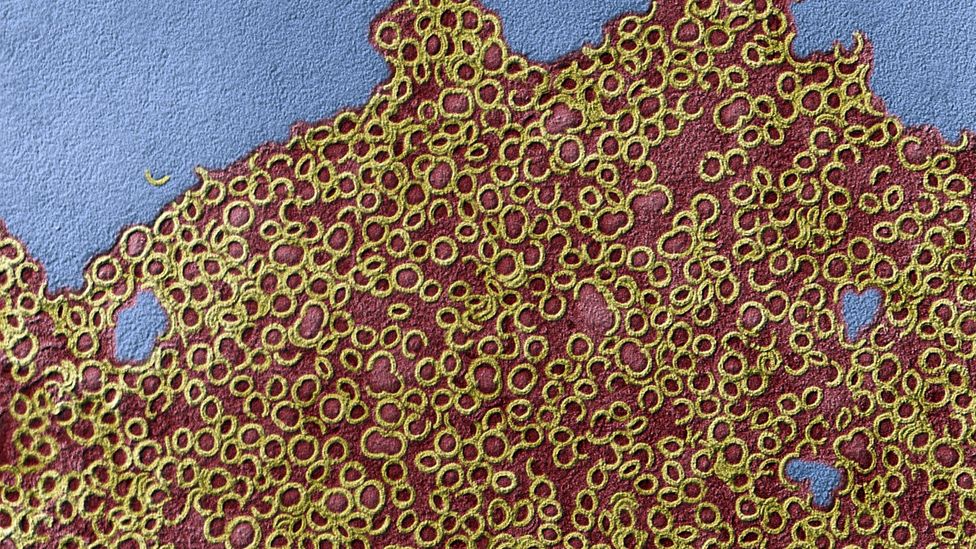
Leaner convert the haemoglobin in blood into sulfhaemoglobin (Credit: Science Photograph Library)
Javan and her squad took samples of liver, spleen, brain, middle and blood from 11 cadavers, at betwixt 20 and 240 hours after expiry. They used ii unlike land-of-the-fine art DNA sequencing technologies, combined with bioinformatics, to analyse and compare the bacterial content of each sample.
The samples taken from different organs in the same cadaver were very similar to each other but very different from those taken from the same organs in the other bodies. This may be due partly to differences in the limerick of the microbiome of each cadaver, or it might be acquired past differences in the time elapsed since expiry. An earlier written report of decomposing mice revealed that although the microbiome changes dramatically after death, it does so in a consequent and measurable way. The researchers were able to estimate fourth dimension of decease to within three days of a nearly ii-month period.
Bacteria checklist
Javan'due south study suggests that this 'microbial clock' may be ticking within the decomposing human body, too. It showed that the bacteria reached the liver about 20 hours afterwards death and that information technology took them at least 58 hours to spread to all the organs from which samples were taken. Thus, after nosotros dice, our bacteria may spread through the body in a systematic way, and the timing with which they infiltrate kickoff one internal organ and then another may provide a new style of estimating the amount of time that has elapsed since death.
"After expiry the composition of the leaner changes," says Javan. "They move into the heart, the brain and then the reproductive organs last." In 2014, Javan and her colleagues secured a $200,000 (£131,360) grant from the National Science Foundation to investigate further. "We will do adjacent-generation sequencing and bioinformatics to see which organ is best for estimating [time of death] – that's nevertheless unclear," she says.
One thing that does seem clear, nevertheless, is that a different limerick of bacteria is associated with different stages of decomposition.

The microbiome of bacteria changes with each hr later death (Credit: Getty Images)
But what does this process actually expect like?
Scattered among the pino copse in Huntsville, Texas, lie around half a dozen homo cadavers in diverse stages of decay. The two most recently placed bodies are spread-eagled nigh the centre of the small enclosure with much of their loose, grey-blue mottled skin still intact, their ribcages and pelvic bones visible betwixt slowly putrefying flesh. A few metres away lies another, fully skeletonised, with its blackness, hardened skin clinging to the bones, equally if information technology were wearing a shiny latex arrange and skullcap. Further still, across other skeletal remains scattered by vultures, lies a third body within a forest and wire cage. Information technology is nearing the stop of the decease wheel, partly mummified. Several big, brown mushrooms abound from where an abdomen one time was.
Natural disuse
For virtually of us the sight of a rotting corpse is at best unsettling and at worst repulsive and frightening, the stuff of nightmares. Simply this is everyday for the folks at the Southeast Texas Applied Forensic Science Facility. Opened in 2009, the facility is located within a 247-acre expanse of national woods owned by Sam Houston Country University (SHSU). Inside information technology, a 9-acre plot of densely wooded land has been sealed off from the wider area and further subdivided, by 10-foot-high green wire fences topped with barbed wire.
In late 2011, SHSU researchers Sibyl Bucheli and Aaron Lynne and their colleagues placed two fresh cadavers here, and left them to decay under natural conditions.
Once self-digestion is under style and bacteria have started to escape from the alimentary canal, putrefaction begins. This is molecular death – the breakdown of soft tissues even farther, into gases, liquids and salts. It is already under way at the earlier stages of decomposition but really gets going when anaerobic bacteria go far on the act.
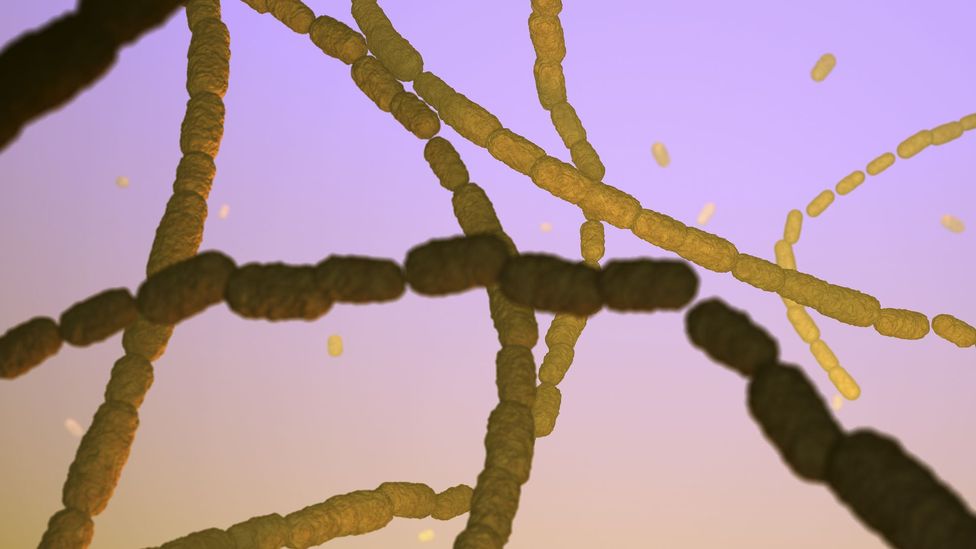
Every dead body is likely to accept its own unique microbial signature (Credit: Science Photo Library)
Putrefaction is associated with a marked shift from aerobic bacterial species, which require oxygen to grow, to anaerobic ones, which do not. These then feed on the trunk's tissues, fermenting the sugars in them to produce gaseous by-products such as methane, hydrogen sulphide and ammonia, which accumulate within the torso, inflating (or 'bloating') the abdomen and sometimes other body parts.
This causes further discolouration of the body. As damaged blood cells continue to leak from disintegrating vessels, anaerobic bacteria convert haemoglobin molecules, which in one case carried oxygen around the body, into sulfhaemoglobin. The presence of this molecule in settled blood gives peel the marbled, dark-green-blackness appearance characteristic of a torso undergoing active decomposition.
Specialised habitat
Equally the gas pressure continues to build up inside the body, it causes blisters to announced all over the skin surface. This is followed by loosening, so 'slippage', of large sheets of skin, which remain barely attached to the deteriorating frame underneath. Eventually, the gases and liquefied tissues purge from the trunk, usually leaking from the anus and other orifices and frequently also leaking from ripped skin in other parts of the body. Sometimes, the pressure is so slap-up that the abdomen bursts open up.
Bloating is often used equally a marking for the transition between early and later stages of decomposition, and another contempo written report shows that this transition is characterised by a singled-out shift in the limerick of cadaveric bacteria.
Bucheli and Lynne took samples of bacteria from various parts of the bodies at the start and the end of the bloat stage. They so extracted bacterial Dna from the samples and sequenced information technology.
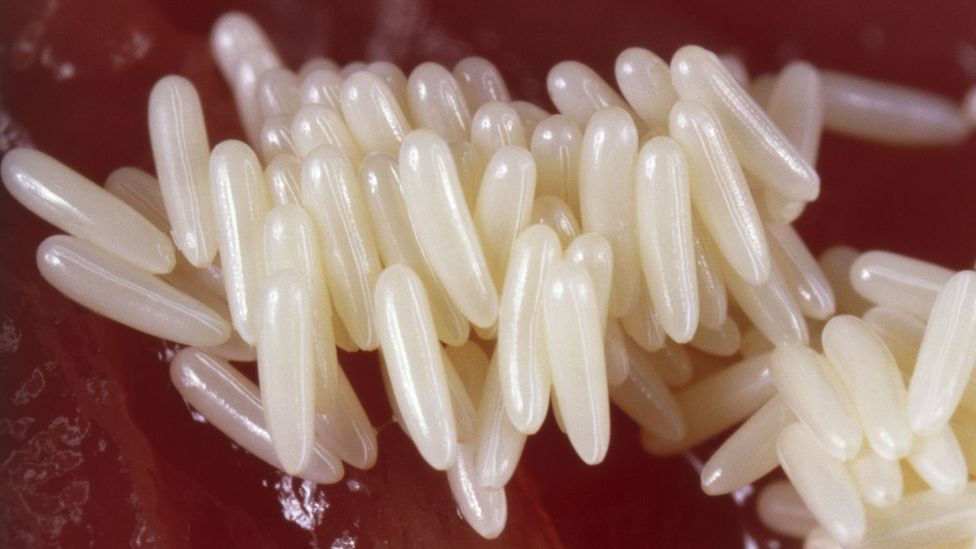
Flies lay eggs on a cadaver in the hours later death, either in orifices or open up wounds (Credit: Science Photo Library)
Equally an entomologist, Bucheli is mainly interested in the insects that colonise cadavers. She regards a cadaver as a specialised habitat for various necrophagous (or 'dead-eating') insect species, some of which run into out their unabridged life bicycle in, on and around the body.
When a decomposing body starts to purge, it becomes fully exposed to its surroundings. At this stage, the cadaveric ecosystem really comes into its own: a 'hub' for microbes, insects and scavengers.
Maggot cycle
Two species closely linked with decomposition are blowflies and flesh flies (and their larvae). Cadavers give off a foul, sickly-sugariness aroma, made upward of a complex cocktail of volatile compounds which changes as decomposition progresses. Blowflies detect the smell using specialised receptors on their antennae, and then land on the cadaver and lay their eggs in orifices and open up wounds.
Each fly deposits around 250 eggs that hatch inside 24 hours, giving rising to small beginning-stage maggots. These feed on the rotting flesh and and then moult into larger maggots, which feed for several hours before moulting again. After feeding some more than, these nonetheless larger, and now fattened, maggots wriggle away from the torso. They then pupate and transform into adult flies, and the cycle repeats until in that location'due south aught left for them to feed on.
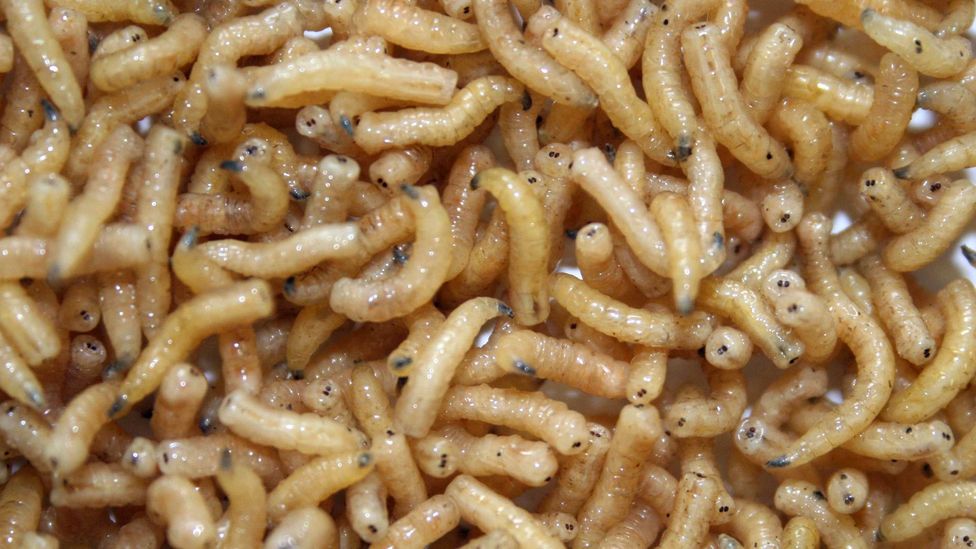
Wriggling maggots generate an enormous amount of estrus inside the torso (Credit: Science Photo Library)
Under the right conditions, an actively decaying torso will have large numbers of stage-three maggots feeding on information technology. This 'maggot mass' generates a lot of heat, raising the inside temperature by more than 10C (18F). Like penguins huddling in the South Pole, private maggots inside the mass are constantly on the move. Just whereas penguins huddle to keep warm, maggots in the mass move around to stay absurd.
"It's a double-edged sword," Bucheli explains, surrounded by large toy insects and a drove of Monster Loftier dolls in her SHSU office. "If you're always at the edge, you might go eaten by a bird, and if yous're always in the center, you might get cooked. So they're constantly moving from the centre to the edges and dorsum."
The presence of flies attracts predators such as skin beetles, mites, ants, wasps and spiders, which and then feed on the flies' eggs and larvae. Vultures and other scavengers, too as other big meat-eating animals, may also descend upon the body.
Unique repertoire
In the absenteeism of scavengers, though, the maggots are responsible for removal of the soft tissues. As Carl Linnaeus (who devised the system by which scientists proper name species) noted in 1767, "three flies could swallow a horse cadaver equally rapidly as a lion". Third-stage maggots will move abroad from a cadaver in large numbers, often following the same road. Their activity is so rigorous that their migration paths may be seen subsequently decomposition is finished, every bit deep furrows in the soil emanating from the cadaver.
Every species that visits a cadaver has a unique repertoire of gut microbes, and different types of soil are likely to harbour distinct bacterial communities – the limerick of which is probably determined by factors such as temperature, moisture, and the soil blazon and texture.
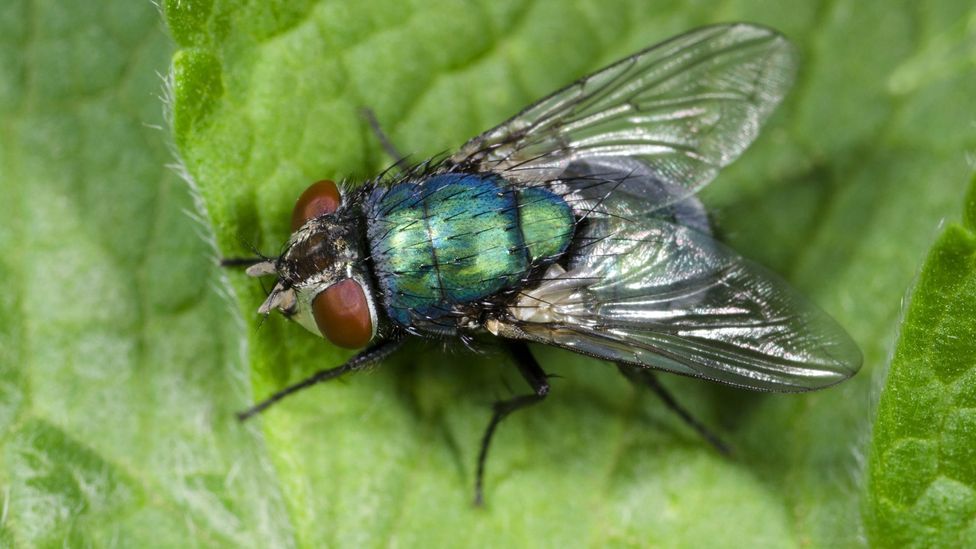
(Credit: Science Photograph Library)
All these microbes mingle and mix within the cadaveric ecosystem. Flies that land on the cadaver will not only deposit their eggs on it, just will likewise take up some of the bacteria they notice there and leave some of their own. And the liquefied tissues seeping out of the body allow the exchange of bacteria between the cadaver and the soil beneath.
When they take samples from cadavers, Bucheli and Lynne detect bacteria originating from the pare on the body and from the flies and scavengers that visit it, likewise equally from soil. "When a torso purges, the gut leaner start to come out, and we encounter a greater proportion of them exterior the body," says Lynne.
Thus, every dead torso is likely to accept a unique microbiological signature, and this signature may change with time according to the exact weather condition of the death scene. A better agreement of the composition of these bacterial communities, the relationships between them and how they influence each other as decomposition proceeds could one day help forensics teams learn more than about where, when and how a person died.
Pieces of the puzzle
For case, detecting Deoxyribonucleic acid sequences known to be unique to a particular organism or soil type in a cadaver could aid criminal offence scene investigators link the trunk of a murder victim to a particular geographical location or narrow downwardly their search for clues fifty-fifty further, possibly to a specific field within a given area.
"In that location have been several courtroom cases where forensic entomology has really stood up and provided important pieces of the puzzle," says Bucheli, adding that she hopes bacteria might provide additional information and could go another tool to refine fourth dimension-of-expiry estimates. "I hope that in nearly v years we tin kickoff using bacterial information in trials," she says.
To this stop, researchers are busy cataloguing the bacterial species in and on the man body, and studying how bacterial populations differ between individuals. "I would dear to have a dataset from life to death," says Bucheli. "I would love to meet a donor who'd let me take bacterial samples while they're alive, through their death process and while they decompose."
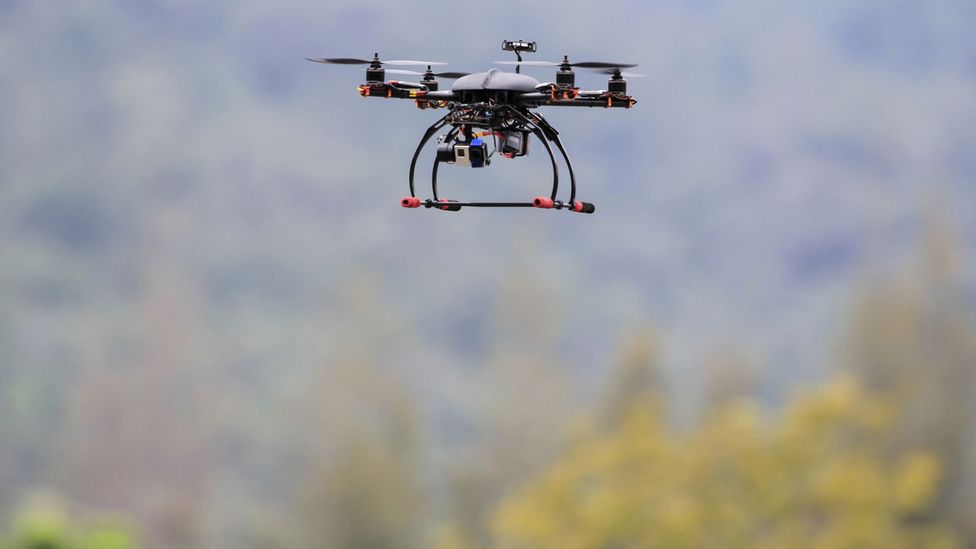
Drones could be used to find buried bodies by analysing soil (Credit: Getty Images)
"Nosotros're looking at the purging fluid that comes out of decomposing bodies," says Daniel Wescott, director of the Forensic Anthropology Center at Texas State University in San Marcos.
Wescott, an anthropologist specialising in skull structure, is using a micro-CT scanner to analyse the microscopic structure of the bones brought back from the trunk farm. He also collaborates with entomologists and microbiologists – including Javan, who has been busy analysing samples of cadaver soil collected from the San Marcos facility – likewise every bit figurer engineers and a pilot, who operate a drone that takes aeriform photographs of the facility.
"I was reading an article about drones flying over crop fields, looking at which ones would be all-time to constitute in," he says. "They were looking at near-infrared, and organically rich soils were a darker colour than the others. I thought if they can do that, and so maybe we tin choice up these little circles."
Rich soil
Those "little circles" are cadaver decomposition islands. A decomposing body significantly alters the chemistry of the soil below information technology, causing changes that may persist for years. Purging – the seeping of broken-downwardly materials out of what's left of the torso – releases nutrients into the underlying soil, and maggot migration transfers much of the energy in a body to the wider surround.
Eventually, the whole process creates a 'cadaver decomposition isle', a highly full-bodied area of organically rich soil. As well equally releasing nutrients into the wider ecosystem, this attracts other organic materials, such as expressionless insects and faecal matter from larger animals.
According to i estimate, an average homo body consists of fifty–75% h2o, and every kilogram of dry body mass eventually releases 32g of nitrogen, 10g of phosphorous, 4g of potassium and 1g of magnesium into the soil. Initially, information technology kills off some of the underlying and surrounding vegetation, possibly because of nitrogen toxicity or because of antibiotics found in the body, which are secreted by insect larvae every bit they feed on the mankind. Ultimately, though, decomposition is beneficial for the surrounding ecosystem.
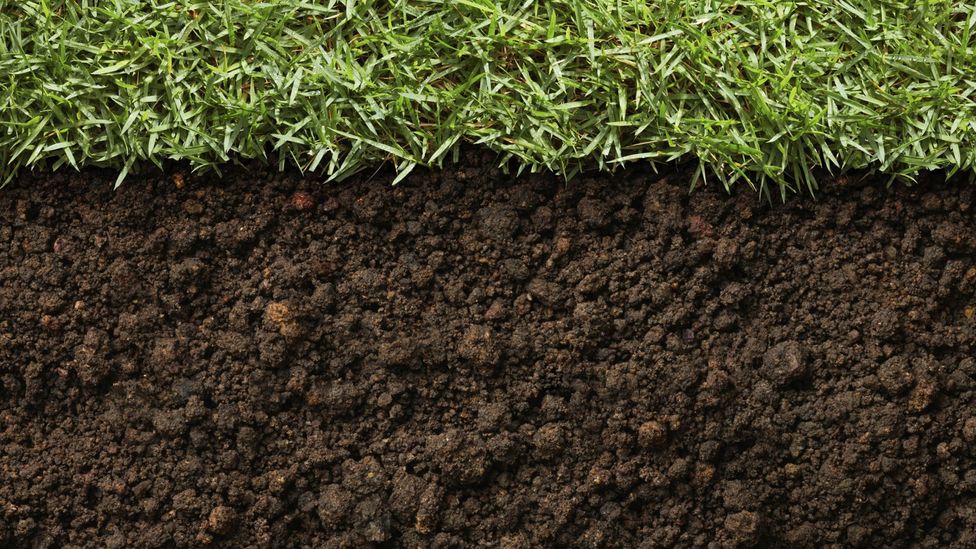
A dead trunk'due south minerals continue to leach into soil months afterward death (Credit: Getty Images)
The microbial biomass within the cadaver decomposition island is greater than in other nearby areas. Nematode worms, associated with disuse and drawn to the seeping nutrients, get more arable, and plant life becomes more than diverse. Further inquiry into how decomposing bodies alter the environmental of their environs may provide a new way of finding murder victims whose bodies take been buried in shallow graves.
Grave soil analysis may also provide some other possible way of estimating time of death. A 2008 study of the biochemical changes that take place in a cadaver decomposition island showed that the soil concentration of lipid-phosphorous leaking from a cadaver peaks at effectually 40 days later decease, whereas those of nitrogen and extractable phosphorous peak at 72 and 100 days, respectively. With a more detailed understanding of these processes, analyses of grave soil biochemistry could 1 day assistance forensic researchers to estimate how long agone a torso was placed in a hidden grave.
This is an edited version of an commodity originally published past Mosaic, and is reproduced nether a Creative Eatables licence. For more about the issues around this story, visit Mosaic'south website here.
Share this story on Facebook , Google+ or Twitter .
whistlerlizabilings54.blogspot.com
Source: https://www.bbc.com/future/article/20150508-what-happens-after-we-die
0 Response to "Real Life Baby Died of Malnutrition After Parents â€ëœrefused to Get Help for Religious Reasonsã¢â‚¬â„¢"
Post a Comment